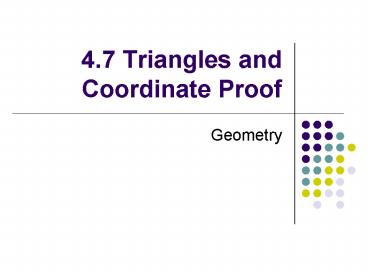4.7 Triangles and Coordinate Proof PowerPoint PPT Presentation
1 / 22
Title: 4.7 Triangles and Coordinate Proof
1
4.7 Triangles and Coordinate Proof
- Geometry
2
Objectives
- Place geometric figures in a coordinate plane.
- Write a coordinate proof.
3
Assignment
- pp. 246-249 1-28 all
- Quiz after this section similar quiz on pg.
250. - Chapter 4 Review pgs. 252-254 1-18
- Extra Credit Algebra Review pgs. 258-259 1-66
all SHOW ALL WORK. - Test next week before break. If you intend to
leave early . . . Take the test before you leave.
Binders are due that day.
4
Placing Figures in a Coordinate Plane
- So far, you have studied two-column proofs,
paragraph proofs, and flow proofs. A COORDINATE
PROOF involves placing geometric figures in a
coordinate plane. Then you can use the Distance
Formula (no, you never get away from using this)
and the Midpoint Formula, as well as postulate
and theorems to prove statements about figures.
5
Ex. 1 Placing a Rectangle in a Coordinate Plane
- Place a 2-unit by 6-unit rectangle in a
coordinate plane. - SOLUTION Choose a placement that makes finding
distance easy (along the origin) as seen to the
right.
6
Ex. 1 Placing a Rectangle in a Coordinate Plane
- One vertex is at the origin, and three of the
vertices have at least one coordinate that is 0.
7
Ex. 1 Placing a Rectangle in a Coordinate Plane
- One side is centered at the origin, and the
x-coordinates are opposites.
8
Note
- Once a figure has been placed in a coordinate
plane, you can use the Distance Formula or the
Midpoint Formula to measure distances or locate
points
9
Ex. 2 Using the Distance Formula
- A right triangle has legs of 5 units and 12
units. Place the triangle in a coordinate plane.
Label the coordinates of the vertices and find
the length of the hypotenuse.
10
Ex. 2 Using the Distance Formula
- One possible placement is shown. Notice that one
leg is vertical and the other leg is horizontal,
which assures that the legs meet as right angles.
Points on the same vertical segment have the
same x-coordinate, and points on the same
horizontal segment have the same y-coordinate.
11
Ex. 2 Using the Distance Formula
- You can use the Distance Formula to find the
length of the hypotenuse. - d v(x2 x1)2 (y2 y1)2
- v(12-0)2 (5-0)2
- v169
- 13
12
Ex. 3 Using the Midpoint Formula
- In the diagram, ?MLN ? ?KLN). Find the
coordinates of point L. - Solution Because the triangles are congruent,
it follows that ML ? KL. So, point L must be the
midpoint of MK. This means you can use the
Midpoint Formula to find the coordinates of point
L.
13
Ex. 3 Using the Midpoint Formula
- L (x, y) x1 x2, y1 y2
- 2 2
- Midpoint Formula
- 1600 , 0160
- 2 2
- Substitute values
- (80, 80)
- Simplify.
14
Writing Coordinate Proofs
- Once a figure is placed in a coordinate plane,
you may be able to prove statements about the
figure.
15
Ex. 4 Writing a Plan for a Coordinate Proof
- Write a plan to prove that SQ bisects ?PSR.
- Given Coordinates of vertices of ?PQS and ?RQS.
- Prove SQ bisects ?PSR.
- Plan for proof Use the Distance Formula to find
the side lengths of ?PQS and ?RQS. Then use the
SSS Congruence Postulate to show that ?PQS ?
?RQS. Finally, use the fact that corresponding
parts of congruent triangles are congruent
(CPCTC) to conclude that ?PSQ ??RSQ, which
implies that SQ bisects ?PSR.
16
Ex. 4 Writing a Plan for a Coordinate Proof
- Given Coordinates of vertices of ?PQS and ?RQS.
- Prove SQ bisects ?PSR.
17
NOTE
- The coordinate proof in Example 4 applies to a
specific triangle. When you want to prove a
statement about a more general set of figures, it
is helpful to use variables as coordinates. - For instance, you can use variable coordinates to
duplicate the proof in Example 4. Once this is
done, you can conclude that SQ bisects ?PSR for
any triangle whose coordinates fit the given
pattern.
18
No coordinates just variables
19
Ex. 5 Using Variables as Coordinates
- Right ?QBC has leg lengths of h units and k
units. You can find the coordinates of points B
and C by considering how the triangle is placed
in a coordinate plane. - Point B is h units horizontally from the origin
(0, 0), so its coordinates are (h, 0). Point C
is h units horizontally from the origin and k
units vertically from the origin, so its
coordinates are (h, k). You can use the Distance
Formula to find the length of the hypotenuse QC.
C (h, k)
hypotenuse
k units
B (h, 0)
Q (0, 0)
h units
20
Ex. 5 Using Variables as Coordinates
- OC v(x2 x1)2 (y2 y1)2
- v(h-0)2 (k - 0)2
- vh2 k2
C (h, k)
hypotenuse
k units
B (h, 0)
Q (0, 0)
h units
21
Ex. 5 Writing a Coordinate Proof
- Given Coordinates of figure OTUV
- Prove ?OUT ? ?UVO
- Coordinate proof Segments OV and UT have the
same length. - OV v(h-0)2 (0 - 0)2h
- UT v(mh-m)2 (k - k)2h
22
Ex. 5 Writing a Coordinate Proof
- Horizontal segments UT and OV each have a slope
of 0, which implies they are parallel. Segment
OU intersects UT and OV to form congruent
alternate interior angles ?TUO and ?VOU. Because
OU ? OU, you can apply the SAS Congruence
Postulate to conclude that ?OUT ? ?UVO.

